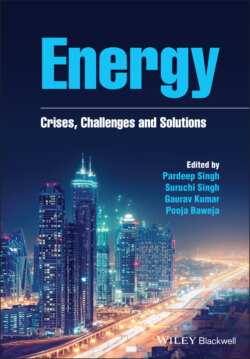Читать книгу Energy - Группа авторов - Страница 2
Table of Contents
Оглавление1 Cover
2 Title Page
3 Copyright Page
4 Preface
5 List of Contributors
6 1 Energy Crisis and Climate Change 1.1 Introduction 1.2 Energy Crisis 1.3 Role of Renewable Energy in Sustainable Development 1.4 Climate Change and Energy Crisis 1.5 Climate Change 1.6 Cleaner Alternatives to Coal to Alleviate Climate Change 1.7 Climate Change and Energy Demand 1.8 Mitigation Measures for the Energy Crisis and Global Warming: Reduce Emissions of Greenhouse Gases (IPCC) 1.9 Conclusion 1.10 Future Considerations References
7 2 Advances in Alternative Sources of Energy 2.1 Introduction 2.2 Need of Novel Research in Alternative Sources of Energy 2.3 Recent Advances in Renewable Sources of Energy 2.4 Future Fuel: Hydrogen 2.5 Challenges 2.6 Future: Alternative Sources of Energy 2.7 Conclusions References
8 3 Recent Advances in Alternative Sources of Energy 3.1 Introduction 3.2 Different Innovations Employed in Major Types of Alternative Sources of Energy 3.3 Environmental Impacts 3.4 Future Prospects 3.5 Conclusions References
9 4 Energy and Development in the Twenty‐First Century – A Road Towards a Sustainable Future 4.1 Introduction 4.2 Energy Consumption and Economic Development 4.3 Environmental Issues – A Corollary of Economic Development 4.4 Air Quality – Deterioration Leading to Development of another Mars 4.5 Carbon Footprints – Gift of Mankind to Mother Earth 4.6 Sustainable Development 4.7 Coronavirus Pandemic and its Impact on the Carbon Emission 4.8 Conclusion References
10 5 Energy Development as a Driver of Economic Growth 5.1 Introduction 5.2 Energy and Economic Development 5.3 Energy Services in Developing Nations 5.4 Energy Supplies in the Developing Nations 5.5 Energy and the Environment in Developing Nations 5.6 Conclusion References
11 6 Pathways of Energy Transition and Its Impact on Economic Growth 6.1 Introduction 6.2 The Rationale for Public Investment in Research and Development in Energy Sector 6.3 Overview of the Electricity Sector in Brazil 6.4 Market Structure 6.5 Programmes and Laws Under the Government of Brazil 6.6 An Overview of the Sources of Finance in the Energy Sector: Brazil 6.7 Climate‐Resilient Growth: Environmental Consequences 6.8 Social Consequences: Availability, Affordability and Accessibility 6.9 The Political Economy of Energy Transition: A Brazilian Experience 6.10 Interlinking Economic Growth and Energy Use: A Theoretical Construct 6.11 Conclusion References Websites Appendix A
12 7 Renewable Energy 7.1 Introduction 7.2 Sources of Renewable Energy 7.3 Advantages and Disadvantages of Various Renewable Energy Resources 7.4 Importance of Renewable Energy 7.5 Benefits of Renewable Energy Production to the Society 7.6 Renewable Energy and Sustainable Development Goals 7.7 Limitations in Renewable Energy 7.8 Current Status and Future Perspectives 7.9 Conclusion References
13 8 Clean Energy Sources for a Better and Sustainable Environment of Future Generations 8.1 Introduction 8.2 Conventional Sources of Energy 8.3 Environmental Impacts of Renewable Resources 8.4 Mitigation Strategies and Sustainable Development of Renewable Resources 8.5 Biomass and Microorganisms‐Derived Energy 8.6 Alternative Energy Resources 8.7 Challenges: Implementation to the Usage of Renewable Energy 8.8 Conclusion References
14 9 Sustainable Energy Policies of India to Address Air Pollution and Climate Change 9.1 Introduction 9.2 Energy Sector of India 9.3 India's Potential and Policies to Exploit Renewable Sources 9.4 National Strategies to Promote Renewable Energy: Policy Framework with Their Objectives 9.5 Financial Instruments to Promote Renewable Sources in India 9.6 Conclusion References
15 10 A Regime Complex and Technological Innovation in Energy System 10.1 Introduction 10.2 Brazil: Its Changing Role in Global Governance 10.3 Brazilian Energy: A Regime Complex 10.4 Implications of Climate Regime on Brazilian Energy Regime 10.5 A Shift in Energy Regime: Technological Innovations in Energy Sector 10.6 Conclusion References Websites Appendix A
16 11 Opportunities in the Living Lights 11.1 Introduction 11.2 History of Bioluminescence 11.3 Bioluminescence in Terrestrial Organisms 11.4 Bioluminescence Molecules 11.5 Bioluminescent Fungi 11.6 Opportunities in Fungal Bioluminescence 11.7 Conclusion References
17 12 Production of Liquid Biofuels from Lignocellulosic Biomass 12.1 Introduction 12.2 Ethanol from Lignocellulosic Biomass 12.3 Bio‐gasoline from Lignocellulosic Biomass 12.4 Jet Fuels from Lignocellulosic Biomass 12.5 Conversion of Lignin to Hydrocarbons 12.6 Conclusion References
18 13 Sustainable Solution for Future Energy Challenges Through Microbes 13.1 Introduction 13.2 Importance of Energy and Energy Statistics 13.3 Brief History of Biofuels 13.4 Classification of Biofuels 13.5 Conclusions References
19 14 Fungal Microbial Fuel Cells, an Opportunity for Energy Sources 14.1 Introduction 14.2 General Introduction of Microbial Fuel Cells (MFCs) 14.3 Factor Affecting the MFCs’ Performance 14.4 Fungal Microbial Fuel Cells 14.5 Other Fungi Used as a Biocatalyst in Microbial Fuel Cells 14.6 Batteries Design with the Use of Fungal Electrode 14.7 Application of MFCs 14.8 Challenges and Future Prospective 14.9 Conclusion Acknowledgements References
20 15 Current Perspective of Sustainable Utilization of Agro Waste and Biotransformation of Energy in Mushroom 15.1 Introduction 15.2 Sustainable utilization of Agro waste Through Mushroom Cultivation Technology 15.3 Lignocellulosic Biomass 15.4 Spent Mushroom Substrate (SMS) 15.5 Biotransformation of the Spent Mushroom Substrate (SMS) Into Energy 15.6 Challenges 15.7 Conclusion References
21 Index
22 End User License Agreement
